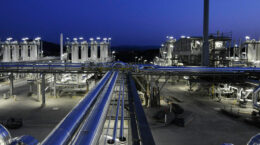BASF with know-how for sustainable mobility at the IAA Cars 2015
- Less fuel consumption and emissions, more comfort, better safety with BASF materials
- Lightweight solutions for components in chassis, powertrain, interior and exterior
Ludwigshafen, Germany - August 14, 2015 - At this year’s IAA Cars, Germany, BASF shows how automotive manufacturers can save weight and reduce emissions as well as improve safety, comfort and fuel efficiency with innovative plastics, catalysts and battery materials. From September 15 to 18, trade show visitors have the possibility to see for themselves in hall 4.1 the variety of functional materials and solutions for the mobility of the present and the future by means of showcase components for chassis, powertrain, interior and exterior.
For more driving comfort: vibration-isolating chassis components
With the microcellular polyurethane elastomer Cellasto®, BASF offers a tailor-made solution for reducing NVH effects (NVH: noise, vibration, harshness) in vehicles. At the stand, top mounts, head-up-display mounts as well as electric motor mounts in different material combinations will be displayed. Top mounts made of Cellasto® contribute to considerable weight reductions while the head-up-display mounts can eliminate disturbing vibrations in different surrounding conditions. The electric motor mounts fit the requirements of electric and hybrid vehicles because of their lightweight, compact design and extraordinary acoustic isolation.
Lightweight and low-emission: plastics, catalysts and battery materials for the powertrain
The world’s first plastic transmission crossbeam in the rear axle subframe was developed by ContiTech Vibration Control and BASF for the S-Class from Mercedes-Benz. It is made from the engineering plastic Ultramid® A3WG10 CR, a specialty polyamide from BASF which is particularly reinforced and optimized to withstand high mechanical loads. Compared to the previous beam made from die-cast aluminum, this highly durable component offers a weight saving of 25%, better acoustics as well as excellent mechanical properties even at high temperatures and conforms to the latest crash requirements.
New catalysts and battery materials by BASF enable vehicles to have a lower environmental impact, whatever powertrain technology they use. The single-component EMPRO™ FWC™ four-way conversion catalyst can remove particulate matter as well as carbon monoxide, hydrocarbons and nitrogen oxides from gasoline-engine exhaust. This can help automakers meet strict new emissions regulations including Euro 6c, while reducing system complexity, tooling and overall system cost.
The patented EMPRO™ SCR.2F (Selective Catalytic Reduction on Filter) technology combines SCR with a diesel particulate filter to control nitrogen oxides and particulate matter emissions on a single substrate, saving weight and space. For full electric, plug-in, and hybrid vehicles, BASF’s advanced cathode materials and electrolytes offer high power as well as energy, safety, and improved efficiency for lithium-ion batteries.
BASF shows different materials for engine cover noise reduction. One example is the thermally stable Basotect® TG melamine foam, which is now being used for the acoustic layer in the Volkswagen EA888 engine for the Jetta, Golf, Passat, Tiguan, and Beetle models produced in North America. The use of Basotect® provides not only superior noise absorption, but also flame retardance and high weight reduction due to its component weight of under 20kg/m³. Basotect® TG is the only thermoset melamine foam, which is specially manufactured for thermoforming to make sophisticated three-dimensional components for tight spaces.
Another possibility for reducing noises under the hood is the flexible polyurethane integral foam Elastofoam® I that is used to produce lightweight engine covers with the one-shot process, i.e. with one material in one process step. The soft cover is produced by the Austrian company Polytec Car Styling and fitted as in various car models of the Swedish car manufacturer Volvo. The sound-absorbing material for the flexible visible part shows a low component density of 140kg/m³. It is dimensionally stable, media-resistant as well as resistant to thermal aging up to 150°C.
Design and safety for the car exterior
As the first manufacturer of thermoplastic polyurethane (TPU), BASF has successfully optimized the material so that it can be applied extensively and unpainted on the vehicle exterior. PSA Peugeot Citroën uses the new TPU grade Elastollan® AC 55D10 HPM (High Performance Material) for cladding the Citroën C4 Cactus with so-called Airbumps®. These are large air-filled cushion bumpers in contrasting colors: They are fitted on the sides as well as on the front and rear of the vehicle, protect the car exterior from impact and scratches and give the vehicle its distinctive look.


